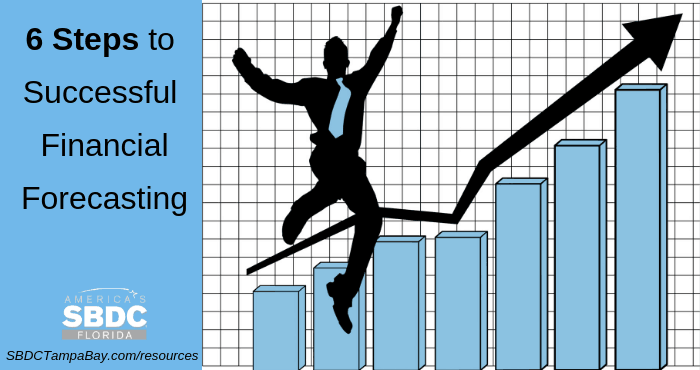Six Steps to Financial Forecasting in Business

by Mitch Lairmore | November 6, 2018
A business plan is an absolute necessity if your business needs other people’s money (OPM) to get off the ground. A business plan is also very important for planning the cash needs for your new business or new initiative for your existing business.
I have found that most entrepreneurs can readily form a vision for their business that can be described in the “plan” portion of the business plan. The plan part of the business plan is the “story” or text where you describe your offering, customer, market size, competition and operating plan.
However, a number of entrepreneurs struggle when developing the “forecast” part of the business plan. The forecast includes your projected revenue and costs. The forecast results in the three key financial reports for the business which are the income statement, balance sheet and cash flow statement.
Developing a forecast is challenging because it is a prediction of the future. It can be intimidating to start the forecast process and therefore business owners will sometimes “outsource” the business planning process It isn’t always clear “where to start” if you haven’t done this before. This isn’t the ideal approach because the business planning process can help the entrepreneur think strategically about their business and prepare them to explain the business model to potential lenders and investors. The six steps below can help entrepreneurs break down the forecast effort into manageable tasks.
Step 1: Define Revenue Forecast Type
This is a key step because it builds a foundation for later steps. Decide what you want to use for your revenue forecast metric. Include product/service categories that are critical to your business model. The key thing to think about is the level of detail that will be useful for long term planning.
Most businesses have more than one product or service. The forecast will be too complicated if you try to forecast each potential offering. Therefore, it will be necessary to aggregate products and services into a forecast unit. An example of this is restaurants. It would be too difficult to forecast each menu item. A more appropriate forecast unit might be average total check or transaction. It may be useful to break that down into average food versus beverage transactions.
The same approach can be used for product businesses where the forecast unit can be the average product instead of every stock keeping unit (SKU). If possible, try to include units in your forecast because it can be easier to attribute costs to units rather than revenue. If you forecast in units it will allow you to vary your assumption around price over the period of the forecast.
Step 2: Create a 12-month Revenue
Using the units defined in Step 1, prepare a monthly forecast for each offering. Keep in mind this is your sales goal. Think about specific customers you might sell to each month. Try to be realistic but don’t over think this and get stalled in the process because this is just a starting point.
Step 3: Add Direct Costs
Direct costs include any expense that is directly related to the offering. The amount of direct costs should be correlated with revenue. If the expense occurs whether you sell something or not, it is not a direct cost. Examples of direct costs include: material (used in the product), merchant fees, shipping and possibly labor. Labor can be categorized as direct or fixed costs.
Step 4: Add Fixed Expenses
Some fixed costs are fairly straightforward to estimate. This includes rent, telephone, insurance, internet, etc.
Step 5: Add “Discretionary/Variable” Fixed Expense
Some “fixed” expenses, or costs that are not direct, are somewhat discretionary. This includes items such as marketing, sales and research and development. The investment in these categories can impact sales.
Keep in mind the time lag between when the expense occurs and the resultant impact on sales. Think about how much marketing you need and when you need to spend to realize the sales you projected in Step 2. This step may include some multiple iterations as you think about how these investments may impact sales.
Step 6: Add Other Items That Impact Cash
At this point you should consider other decisions regarding your business that impact cash flow. This includes such things as assets and terms. Physical assets include items such as machinery, vehicles and build outs. Terms would include the credit terms you would give to your customers and the credit your suppliers would provide to you.
Developing financial forecasts is a critical part of the business planning process. Following these six steps can help the businessperson navigate through this process in a structured manner. Once the initial forecast has been developed, the entrepreneur can use this model to investigate alternative strategies.
When in doubt, reach out to local economic development resources to see if you are on the right path. There are no-cost resources available at the city, county, and state levels, for businesses.




